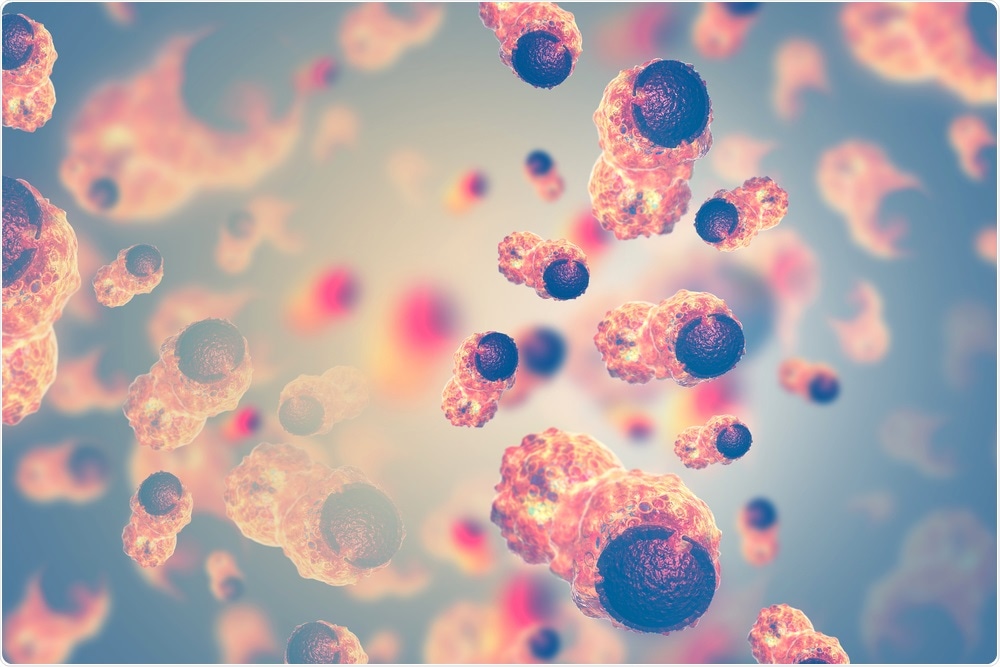Fresh insights into why some harmful substances are so efficient at causing cancer could aid the quest for better treatments.

Image Credit: crystal light/Shutterstock.com
New research reveals how chemicals can cause changes in cells to help them dodge the body's immune system and build resistance to cancer drugs.
Scientists tracked the impact of a toxic substance - similar to compounds found in tobacco, exhaust, and some plants - to better understand how chemicals cause mutations in our cells' DNA.
The team found that damage caused by the substance lingered long enough to be inherited when a cell divides. The damage stops cells' replication machinery reading DNA sequences correctly giving a high chance of a new mutation each time a new copy is made.
Each cell division with the damage produces a new combination of mutations. Because only certain combinations of mutations will turn healthy cells cancerous, the more combinations produced, the greater the chances of disease.
This rapid increase in new combinations of mutations means more throws of the genetic dice that are capable of producing cancer cells.
The greater genetic diversity introduced into cells as a result of these extra throws provides more opportunities for tumors to evade the body's immune system and develop resistance to treatment.
The unique mutation patterns recognized by the team allowed them to trace back to the point where a tumor develops. This new found clarity will aid future research to understand the mechanisms behind cancer development and DNA repair processes.
A group led by the Universities of Edinburgh and Cambridge and the German Cancer Research Center identified the specific combinations of mutations that will create cancer cells. The findings could help doctors prescribe the most appropriate course, and dosage, of chemotherapy for patients.
The team studied how cancer cells evolved in the livers of mice given the tumor-causing chemical, diethylnitrosamine. It causes lingering DNA damage like that triggered by a chemical called aristolochic acid, which is found in some plants and herbal medicine and linked to liver cancer.
The DNA damage is also similar to that caused by UV light and a wide range of polycyclic aromatic hydrocarbons present in tobacco smoke, vehicle exhaust, and some burnt food. Temozolomide and other drugs used in chemotherapy were also found to produce lingering DNA damage.
All of the mutations had a clear pattern that suggested damage took place on just one of the two DNA helix strands. This process, where most mutations stem from damage to a single strand, is now known as lesion segregation. Knowing segregation had occurred, helped the team pinpoint the cancer-causing mutations.
Having identified mutation patterns in mice, the team used published data from human cells, to find evidence of lesion segregation in cancer patients that had been caused by chemicals and ultraviolet radiation.
The research is the result of a collaboration between researchers from EMBL European Bioinformatics Institute near Cambridge and the Institute for Research in Biomedicine, Barcelona.
The study is published in Nature. It was funded by Cancer Research UK with support from the European Research Council, the Wellcome, the Helmholtz Society, and the Medical Research Council.
Professor Martin Taylor, University of Edinburgh's MRC Human Genetic Unit, said: "DNA lesions caused by cancer-causing agents are individual to each strand and can trigger several generations of mutations. It is important to be aware of this when tumors are being treated and new drugs are being developed."
The concept of lesion segregation helps us better understand how the surprising complexity of mutations in cancer cells can arise. It may help explain how cancer cells can react so flexibly and, in turn, shape cancer genome evolution."
Dr. Duncan Odom, University of Cambridge's Cancer Research UK Cambridge Institute
Dr. Sarah Aitken, University of Cambridge, said: "In the end, those cancer cells that carry the most favorable pattern of mutations will prevail. They can grow the fastest, escape the immune system, and possibly survive therapies better."